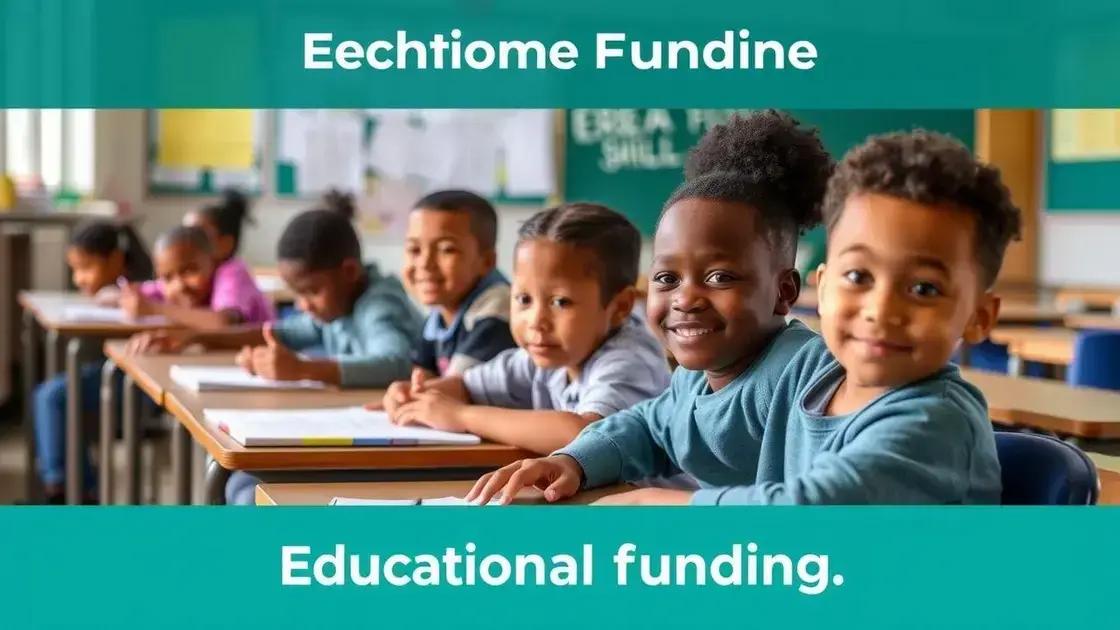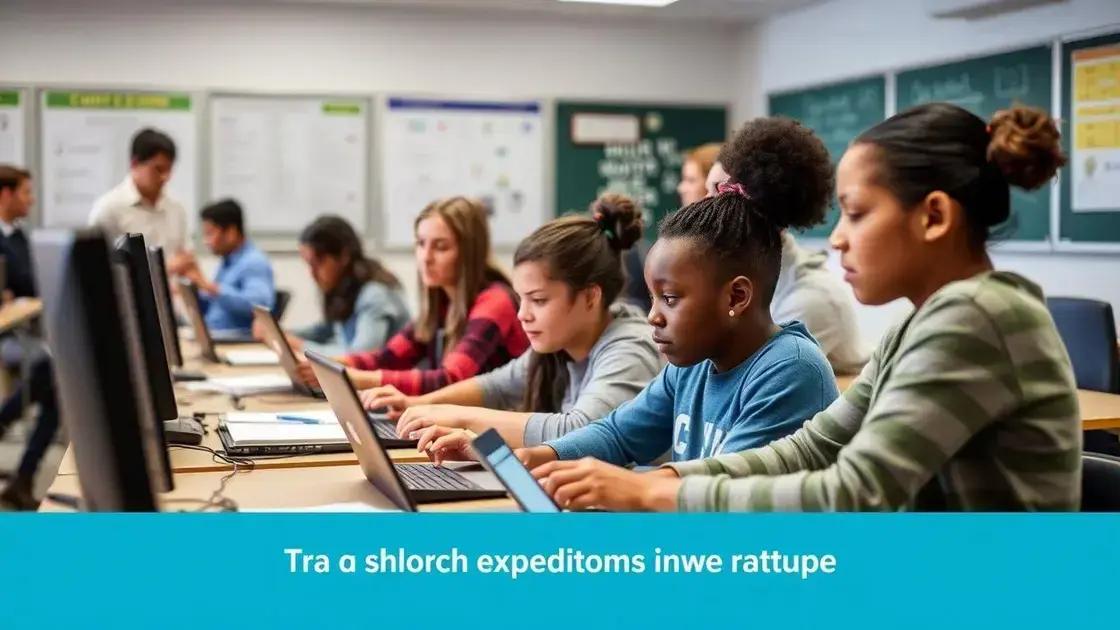Public school funding: why it matters now more than ever

Anúncios
Public school funding is primarily derived from local property taxes, state support, and federal grants, directly impacting the quality of education and resources available to students across various communities.
Public school funding is a topic that influences every aspect of education. Have you ever wondered how funding decisions shape the quality of education your child receives? Let’s dive into its significance.
Anúncios
Understanding public school funding mechanisms
Understanding how public school funding works is crucial for grasping its impact on education. Schools rely on various sources to fund their operations, and knowing these mechanisms helps clarify why funding is uneven across districts.
One of the main sources of funding comes from local property taxes. This means that schools in wealthier areas often have more resources than those in less affluent neighborhoods. The disparity raises important questions about equity in education.
Anúncios
Types of Funding Sources
Public education mainly receives money from three sources:
- Local funding: Primarily generated through property taxes.
- State funding: Distributed based on enrollment and specific needs of the district.
- Federal funding: Allocated for special programs, such as those supporting low-income students.
These funding sources create a complex landscape. In many instances, state funding aims to bridge the gaps created by local taxes, ensuring that every child receives at least a minimum education. However, this can vary significantly from state to state, affecting how schools allocate their budgets.
The Role of Grants
Another vital aspect to consider is the role of grants. Many schools seek federal and state grants to fund specific projects or programs. These grants can cover everything from technology upgrades to arts education, enriching the school experience. However, competition for these funds can be fierce, leaving some schools at a disadvantage.
Furthermore, community support is crucial in the funding equation. Fundraising events and donations from local businesses can bolster a school’s budget, allowing for new programs and resources. Engaging the community not only helps with funding, but also fosters a sense of investment in the education system.
By grasping the complexities of public school funding mechanisms, stakeholders can better advocate for policies that promote fair distribution of resources. Understanding these elements also empowers parents and community members to participate actively in funding discussions, contributing to a stronger educational environment for all students.
The impact of underfunding on education quality
The impact of underfunding on education quality is significant and far-reaching. Schools that lack adequate funding struggle to provide the necessary resources for students to succeed. This can lead to a wide array of challenges that affect both students and teachers.
When schools are underfunded, they often have to make tough choices. Many programs may be cut or eliminated altogether. For example, art and music programs, extracurricular activities, and even support services like counseling might be reduced. This lack of comprehensive education can hinder student development and engagement.
Common Effects of Underfunding
Underfunded schools frequently experience:
- Inadequate resources: Classrooms may lack textbooks, technology, and supplies essential for learning.
- Overcrowded classrooms: Teachers are often faced with larger class sizes, making it harder to provide individual attention.
- Low teacher morale: Educators may feel undervalued when they cannot effectively support their students, leading to job dissatisfaction.
- Lower student performance: Academic outcomes can suffer due to limited resources and support.
These issues create a vicious cycle. As students struggle to perform, schools may receive less funding, which in turn perpetuates the cycle of underfunding. Communities often feel the effects as well, with reduced educational quality affecting local workforce development and economic growth.
Long-Term Consequences
The long-term consequences of underfunding can be severe. When students do not receive a quality education, it impacts their future opportunities. Graduates may find it difficult to secure good jobs or pursue higher education. This can lead to a cycle of poverty that extends beyond the classroom and into communities.
To address these challenges, it is crucial to advocate for equitable funding for all schools. Community engagement and awareness can drive positive change, ensuring that every child has access to quality education. By understanding the impact of underfunding, we can better support efforts to improve education quality.
How public school funding affects educational equity

How public school funding affects educational equity is a critical question for communities and policymakers. Funding disparities can lead to significant differences in educational experiences for students. These disparities often correlate with socioeconomic status, race, and geographic location.
In many cases, schools in wealthy neighborhoods receive more funding through local property taxes, which allows them to offer better facilities, more extracurricular activities, and higher salaries for teachers. This can create an environment where students are more likely to succeed.
Factors Influencing Educational Equity
Several factors contribute to the impact of funding on educational equity:
- Resource allocation: Schools with more funding can provide quality materials, technology, and access to advanced courses.
- Teacher quality: Higher salaries can attract more experienced and qualified teachers, improving student outcomes.
- Special programs: Well-funded schools often have programs for gifted students, special needs services, and after-school activities.
- Support services: Guidance counseling and mental health resources are more available in adequately funded schools, helping students navigate challenges.
When funding is reduced, as seen in many underprivileged areas, the impact can be dire. Schools may have to eliminate programs or increase class sizes, which strains both teachers and students. This not only affects academic performance but also the overall school culture.
The Role of Policy
Policymakers play a vital role in addressing these inequities. Implementing equitable funding formulas can help ensure that all students, regardless of their background, have access to quality education. This means understanding that some districts may require more funding to provide the same level of education available to wealthier districts.
Moreover, community engagement can enhance educational equity. When local residents advocate for better funding, they help shine a light on the needs of their schools. By prioritizing public school funding that addresses these disparities, we can move towards more equitable educational opportunities for all.
Innovative solutions for funding challenges
Innovative solutions for funding challenges in public schools are vital to improving education. As traditional funding sources become insufficient, schools need to explore creative ways to secure resources.
One effective approach is community partnerships. By collaborating with local businesses, schools can gain support in various forms—financial contributions, materials, or mentorship programs. These partnerships foster a sense of shared responsibility and investment in the education of local youth.
Crowdfunding Initiatives
Crowdfunding has emerged as a popular solution for schools facing funding issues. Teachers and administrators can use platforms to raise money for specific projects. Many educators have successfully funded classroom resources, field trips, or technology upgrades through these initiatives.
- Engaging narratives: Sharing stories about the impact of these projects can motivate community members to donate.
- Social media: Utilizing social media to spread the word amplifies the reach of crowdfunding efforts.
- Incentives: Offering incentives, like recognition or small rewards, can increase contributions.
Another innovative solution is the implementation of grant writing programs. Many organizations, including foundations and government entities, offer grants specifically for educational purposes. Schools can form teams to seek out opportunities, develop proposals, and secure funding for various initiatives.
Leveraging Technology
Technology also plays a crucial role in solving funding challenges. Schools can leverage online platforms to connect with potential donors and share their needs. Virtual events, such as online auctions or fundraising challenges, can engage the community and raise funds quickly.
In addition, districts can explore flexible funding models. This includes reallocating existing budgets to prioritize essential programs or services. A careful review of financial resources can uncover areas where adjustments can be made, ensuring that every dollar is used effectively.
By embracing these innovative solutions, schools can address funding challenges and work towards providing a quality education for all students. It is essential to continue seeking out creative ways to fund public education effectively.
The role of community engagement in funding initiatives
The role of community engagement in funding initiatives is essential for the success of public schools. When communities come together to support their schools, they can significantly impact the quality of education available to students.
Community members can help by participating in school events, fundraising activities, and advocacy efforts. Their involvement not only raises money but also builds a strong foundation of support for local schools. Engaged parents and community members often bring valuable resources, whether it’s expertise, time, or connections that can help drive initiatives forward.
Ways to Foster Community Engagement
Here are some effective ways to foster community engagement:
- Host events: Organizing events like school fairs, workshops, or open houses allows families and community members to connect with the school.
- Incorporate local businesses: Partnering with local businesses can create sponsorship opportunities, where businesses contribute funds or resources in exchange for visibility.
- Utilize social media: Schools can use social media platforms to keep the community informed and involved in funding efforts and school activities.
- Encourage volunteer opportunities: Creating opportunities for community members to volunteer can help deepen their connection to the school and its mission.
When community members feel invested in their local schools, they are more likely to support funding initiatives. This support can come in various forms, from donations to helping to write grants. Engaged communities are often more successful in advocating for better funding and resources.
Building Long-Term Relationships
Building long-term relationships between schools and their communities is crucial. Schools should strive to maintain open lines of communication with parents and local organizations. Regular updates about school projects, funding needs, and success stories can keep the community informed and engaged.
When schools actively seek input from parents and community members, they can create programs that reflect the needs and interests of their community. This collaborative effort can lead to more effective funding initiatives, creating a win-win situation for both schools and the community.
FAQ – Frequently Asked Questions about Public School Funding
What are the main sources of public school funding?
Public school funding mainly comes from local property taxes, state funding, and federal grants, which together support various educational programs and resources.
How does community engagement affect school funding?
Community engagement enhances school funding by fostering partnerships and support, allowing schools to secure additional resources through donations and collaborative efforts.
What innovative solutions exist for funding issues in schools?
Innovative solutions include crowdfunding campaigns, forming community partnerships, and applying for grants specifically designated for educational programs.
Why is equitable funding important?
Equitable funding ensures that all students, regardless of their background, have access to quality education and resources, promoting fairness and improved educational outcomes.






